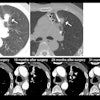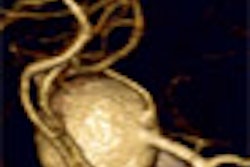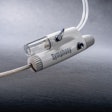In a small percentage of patients who survive bouts of pulmonary emboli, the blood clot in the lungs fails to resolve, causing chronic thromboembolic pulmonary hypertension that requires surgery to repair. Interventional radiologists from Cleveland are now recommending intravascular ultrasound (IVUS) to clearly pinpoint clots and their positions in the arteries.
"We believe that the IVUS performed before surgery to remove these emboli will complement pulmonary angiography studies," said Dr. David Rosenblum, chief of vascular and interventional radiology at the MetroHealth Medical Center in Cleveland.
In a poster presentation at the 2002 International Symposium on Endovascular Therapy (ISET) in Miami Beach, FL, Rosenblum said that ultrasound images could clearly identify large emboli that were less visible on angiography. The two imaging studies should facilitate surgical pulmonary thromboendarterectomy, he said.
"The purpose of the study was to show that pulmonary angiography with intravascular ultrasound is more accurate than pulmonary angiography alone in preoperative assessment of patients with known or suspected chronic thromboembolic pulmonary hypertension," said Jonathan Schweid, the study’s lead author and a second-year student at the Medical College of Ohio in Toledo.
The group performed the studies on 28 patients, 19 of whom were women with a mean age of 51. A right jugular vein approach was used. The vein was cannulated with a Micropuncture needle. A 5-French vascular sheath was placed, and a 5-French pigtail catheter was manipulated into the various arteries of the lung. Then the catheter was withdrawn and was exchanged for an 8-French Ansel 1 Flexor guiding catheter (Cook, Bloomington, IN).
A 6-French, 12.5-MHz Sonicath Ultra IVUS (Boston Scientific Medi-Tech, Natick, MA) catheter was used for the study. It was advanced through the sheath in a monorail fashion over a 0.035-inch, 1.5-mm Rosen wire.
The preliminary study found that intravascular ultrasound identified emboli in two patients where no evidence appeared on angiography studies, Rosenblum said. Ultrasound also ruled out emboli in two other cases of suspicious lesions seen on angiography.
Overall, IVUS was successful in 70% of the cases in finding the exact location of the thromboembolic disease. In the remaining 30%, IVUS confirmed evidence of chronic thromboembolic disease, although the precise intraoperative position of the main thrombus varied slightly.
Rosenblum, also an assistant professor of radiology at Case Western Reserve University in Cleveland, noted that intravascular ultrasound is limited to larger main and lobar vessels. In several cases, the IVUS device could not negotiate some of the blood vessels, and steering the device steadily in the blood vessel was not always possible.
"There is a significant amount of work involved in using the IVUS for this purpose," commented Dr. Barry Katzen, medical director of the Miami Cardiac and Vascular Institute. "To steer the IVUS through all the arteries in the lungs can be difficult."
While the goal of the IVUS is to gain information about the size and location of the emboli, the amount of effort, time, and expense in performing even a minimally invasive procedure might not be practical for most clinicians, he said.
Still, IVUS wouldn't have to be used too often: Less than 1% of survivors of acute pulmonary embolism go on to develop the chronic condition due to failure of the emboli to resolve -- that translates to between 500 and 1,000 patients a year, he said.
"Intravascular ultrasound can provide information on vessel wall thickness that cannot otherwise be detected, and can aid in selecting patients most suitable for surgical thromboendarterectomy," he said.
By Edward SusmanAuntMinnie.com contributing writer
February 4, 2002
Related Reading
Pulmonary embolism discussion, August 29, 2001
Investigational and standard nuclear exams show mettle in detecting emboli, June 29, 2000
Lower extremity venous ultrasound fails to rule out pulmonary embolism, June 9, 2000
Copyright © 2002 AuntMinnie.com



















